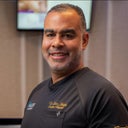Good question. Much of the final look and feel achieved after breast augmentation surgery depends on several factors:




